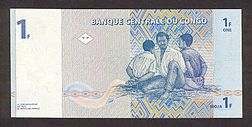- Congolese franc
-
This article is about the currency in the Democratic Republic of the Congo. For the Republic of Congo currency, see Central African CFA franc
Congolese franc franc congolais (French) 
1 franc note (reverse) ISO 4217 code CDF User(s)  Democratic Republic of Congo
Democratic Republic of CongoInflation 16.7% Source The World Factbook, 2007 est. Subunit 1/100 centime Symbol FC Banknotes 1, 5, 10, 20, 50 centimes, 1, 5, 10, 20, 50, 100, 200, 500 francs Central bank Central Bank of the Congo Website www.bcc.cd The franc is the currency of the Democratic Republic of Congo. It is subdivided into 100 centimes.
Contents
First franc, 1887-1967
During Belgian colonial rule, currency denominated in centimes and francs was issued for use in Congo. These francs were equal in value to the Belgian franc. From 1916, the Congolese franc also circulated in Rwanda and Burundi. From 1952, the currency was issued bearing the names Belgian Congo (either "Congo Belge" or "Belgische Congo") and "Ruanda-Urundi".
In 1960, Rwanda and Burundi adopted their own franc, whilst, between 1960 and 1963, Katanga also issued its own franc.
The franc remained Congo's currency after independence until 1967, when the zaïre was introduced, at a rate of 1 zaïre = 1000 francs.
Coins
In 1887, holed, copper coins were introduced in denominations of 1, 2, 5 and 10 centimes, together with silver coins worth 50 centimes, and 1, 2, and 5 francs. Coins ceased to be minted of silver in 1896. Holed, cu pro-nickel 5-, 10- and 20-centime coins were introduced in 1906, with the remaining copper coins (worth 1 and 2 centimes) minted until 1919. Cu pro-nickel 50-centime and 1-franc coins were introduced in 1921 and 1920, respectively.
The coinage of Belgian Congo ceased in 1929, only to be resumed in 1936 and 1937 for the issue of nickel-bronze 5-franc coins. In 1943, hexagonal, brass 2-franc coins were introduced, followed by round, brass coins worth 1, 2 and 5 francs, and silver 50-franc coins, between 1944 and 1947.
In 1952, brass 5-franc coins were issued carrying the name "Ruanda-Urundi" for the first time. http://i.colnect.com/images/items/full/803/109803.jpg
Aluminum coins worth 50 centimes, 1 and 5 francs followed between 1954 and 1957. In 1965, the only franc-denominated coins of the first Democratic Republic of Congo were issued, aluminum coins worth 10 francs.
As with Belgium's own coins, some types were issued in two distinct versions, one with French legends, the other with Dutch legends.
Banknotes
In 1896 the Independent State of Congo issued 10 and 100 franc notes. In 1912, the Bank of Belgian Congo introduced 20 and 1000 francs, followed by notes of 1, 5 and 100 franc notes in 1914. The 1-franc notes were only printed until 1920, whilst 10 franc notes were introduced in 1937. 500 francs were introduced in the 1940s, with 10,000 francs introduced in 1942.
In 1952, the Central Bank of Belgian Congo and Ruanda-Urundi introduced notes for 5, 10, 20, 50 and 100 francs, with 500 and 1000 francs added in 1953.
In 1961, the National Bank of Congo introduced notes for 20, 50, 100, 500 and 1000 francs, some of which were issued until 1964. In 1962, the Monetary Council of the Republic of Congo introduced 1000 franc notes, which were notes of the Central Bank of Belgian Congo and Ruanda-Urundi overprinted with the Monetary Council's name. In 1963, the Monetary Council issued regular type 100 and 5000 franc notes.
Second franc, 1997-
The franc was re-established in 1997, replacing the new zaïre at a rate of 1 franc = 100,000 new zaïres. This was equivalent to 300,000,000,000,000 old francs.
Coins
No circulating coins exist, but there are numerous designs of 25-centime, 50-centime and 1-franc coins made of non-precious metal to be sold to foreign collectors.
Banknotes
In 1997, banknotes were introduced in denominations of 1, 5, 10, 20 and 50 centimes, 1, 5, 10, 20, 50 and 100 francs. 200-franc notes were introduced in 2000, followed by 500-franc notes in 2002.
In 2010, Banque Centrale du Congo issued 20 million 500 franc banknotes to commemorate the country's 50th anniversary of independence from Belgium.[1]
Current CDF exchange rates From Google Finance: AUD CAD CHF EUR GBP HKD JPY USD ZAR From Yahoo! Finance: AUD CAD CHF EUR GBP HKD JPY USD ZAR From OzForex: AUD CAD CHF EUR GBP HKD JPY USD ZAR From XE.com: AUD CAD CHF EUR GBP HKD JPY USD ZAR From OANDA.com: AUD CAD CHF EUR GBP HKD JPY USD ZAR See also
References
- General
- Krause, Chester L. and Clifford Mishler (1991). Standard Catalog of World Coins: 1801–1991 (18th ed. ed.). Krause Publications. ISBN 0873411501.
- Pick, Albert (1994). Standard Catalog of World Paper Money: General Issues. Colin R. Bruce II and Neil Shafer (editors) (7th ed.). Krause Publications. ISBN 0-87341-207-9.
- Specific
External links
- Zaire currency from country data.com
- Histoire de la monnaie au Congo. Banque Centrale du Congo
Currency: Congolese francCommunications Industries: Agriculture Coffee · Banana · Rubber · Palm oil · Rice · Maize · Cassava · Yam · Peanut · Sweet potato · Sugarcane · Pineapple · Sorghum ·Currencies of Africa North Central East - Comorian franc
- Djiboutian franc
- Eritrean nakfa
- Ethiopian birr
- Kenyan shilling
- Seychellois rupee
- Somali shilling
- Somaliland shilling (unrecognized)
- South Sudanese pound
- Tanzanian shilling
- Ugandan shilling
South West {{#if:||
{{#if:||
 Democratic Republic of the Congo topics
Democratic Republic of the Congo topicsPolitics and law History Early history · Colonisation (1867–85) · Congo Free State (1885–1908) · Belgian Congo (1908–60) · Congo-Léopoldville (1960–65) · Congo Crisis (1960–65) · Zaire (1965–97) · First Congo War (1996–98) · Second Congo War (1998–2003) · 2000sGeography Economy and infrastructure Agriculture · Airports · Central Bank · Communications · Energy · Franc · Health · Mining · Resource extraction · TransportCulture and society Categories:- Franc
- Currencies of Africa
- Circulating currencies
- Economy of the Democratic Republic of the Congo
Wikimedia Foundation. 2010.
